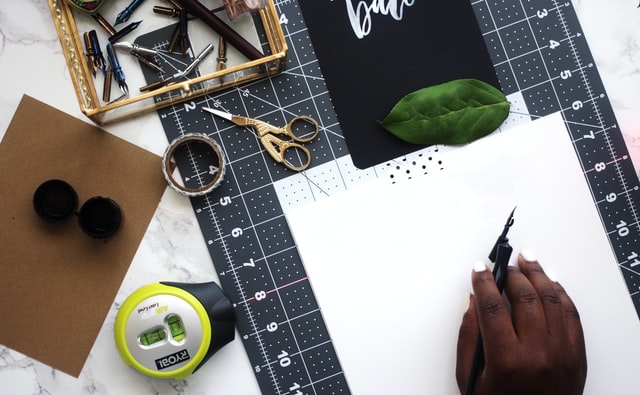

From start to finish, this comprehensive guide will teach you the fundamentals of clothing pattern making. Create a ready-to-wear pattern, a one-of-a-kind pattern, and all in between. You’ll learn how to create patterns from the ground up, as well as how to manipulate them to get the perfect match.
The method of developing a template for your garment is known as pattern making. To sew a dress, a pattern is used as a template to cut out fabric that meets the appropriate requirements. It takes into account the type of fabric, the wearer’s intended fit, and any trims that may be used. The pattern is used to ensure the two-dimensional fabric sits correctly on a three-dimensional body.
The most popular methods of pattern construction are draping and flat patterning. Each solution requires slightly different resources to complete the mission.
Draping is a technique for achieving a desired look by manually manipulating fabric on a dress form. A dress pattern, fabric (your own or a less expensive fabric of identical weight and drape qualities), buttons, pattern paper, a French curve, and a French curve.
Wrap the fabric around the form so it looks the way you want it to, then mark it while it’s still on the form. After that, the fabric is stripped and laid flat. A French curve and ruler are used to tidy up the lines. The designs on the fabric are then transferred to pattern paper. After that, you’d add seam allowances, notches, and other required markings, and finally, you’d true your patterns. Later on, we’ll talk about what all of those terms mean.
Draping is a lot of fun, and it’s often appropriate for really complicated folds, but it’s not as effective or precise as a flat pattern.
As the name suggests, a flat pattern is created on a flat surface. Template paper, a French curve, a straight ruler, and a pencil are used to make manual flat patterns. CAD software is used to create digital flat patterns. If you’re working online or by hand, the drafting methods for making flat patterns are the same.
It is important to use the right body measurements when making a well-fitting garment. But how do you figure out what your body proportions should be? It all depends on who you’re making something for!
If you’re making a custom garment for yourself or someone else, you can use the end wearer’s actual body measurements to build your pattern. To document all of the necessary measurements, you’d usually use a measurement sheet like this one.
But what if you’re a mass-market clothing manufacturer? A more comprehensive body measurement is required. To create the patterns you need, you can find proper body data in a number of ways. The ASTM body data is made up of hundreds of thousands of body scans collected from a number of sources. Alvanon and Human Solution, for example, are third-party body data specialists who can help you customise your data to your specific needs.
A simple pattern, also known as a block pattern, corresponds to body measurements and has only wearing ease. Basic patterns are critical for ensuring that a brand’s fit is consistent. Consistency of fit ensures that your customers will buy their size with confidence each time they buy a product from you, knowing that it will fit. Using a simple pattern library as a starting point for all of your style patterns is the best way to develop this faith.
A good simple pattern library can give you patterns with only the requisite seams for fit and the appropriate amount of wearing ease for the fabrics they’re designed for.
You’ll have a fitting after you’ve finished your pattern and sewn your first sample. It’s possible that you’ll need to make some changes to the suit. There are a variety of reasons why a pattern may not be flawless the first time. Things like the drape of the cloth, any shrinkage that may occur during the sample’s processing, differences in the wearer’s measurements from the drafted body, and so on.
The most popular changes are bust adjustments, which are particularly common on woven garments, to ensure that darts land in the right place. Shoulder slope, raise shape, and neckline adjustments are also common fit adjustments.
All of these things are part of the standard pattern-making procedure, and they can be changed on your patterns after they’ve been fitted.
If you want to learn about the different types of pattern making in clothing or the pattern making process, you’ll need to get an education from a reputable university. The JD Institute Of Fashion Technology is one of the best in the area, offering courses such as pattern making technology and others that follow an industry-focused curriculum to prepare students for real-world situations. JD Institute has received many awards for their contributions to education, including the Times Power Icon Award, the International Glory Award, and the Leaders in Education Award, to name a few. Top designers such as Zara, Tommy Hilfiger, and Sabyasachi have collaborated with students.
Candidates are chosen based on a general aptitude test, or GAT, developed by the department to evaluate the candidate’s technical or creative abilities. Through providing practical advice, the JD council will assist you in staying in touch with the college and other students after graduation. It represents the organization’s goal of assisting participants in broadening their business opportunities through a well-organized, supportive, and skilled referral network that allows them to establish meaningful and long-term relationships with quality industry professionals. Enroll now to take advantage of this fantastic opportunity!